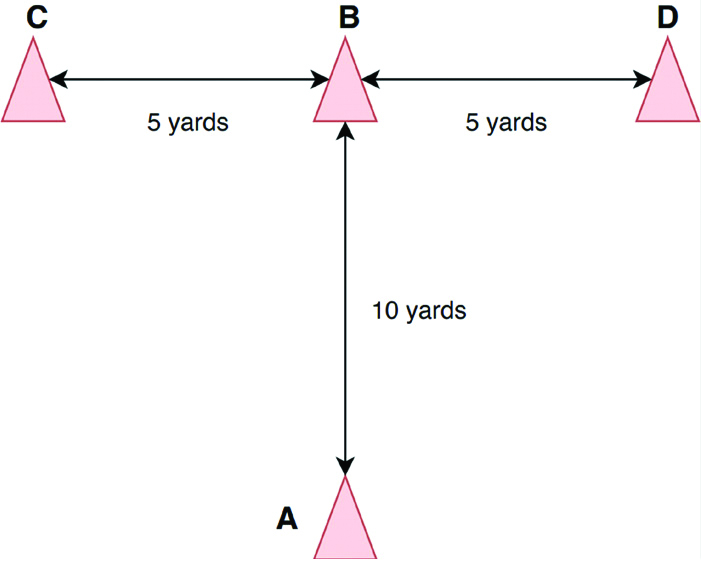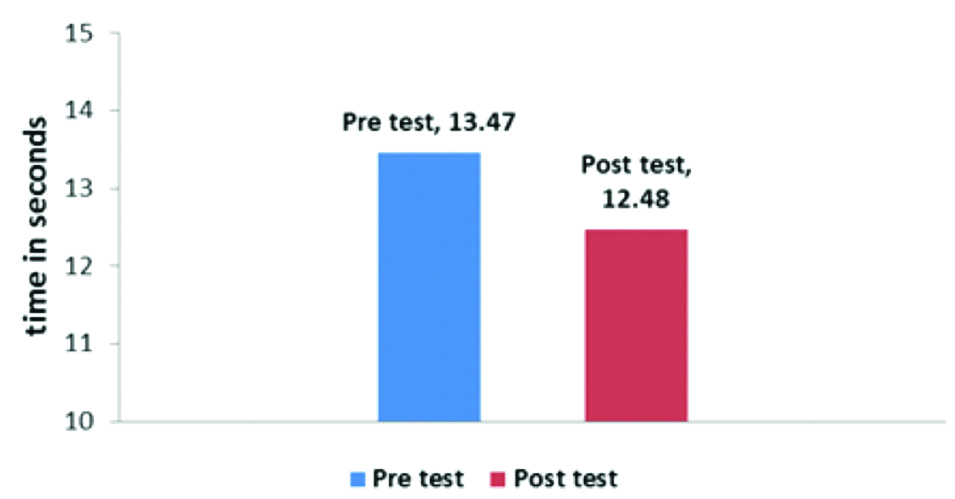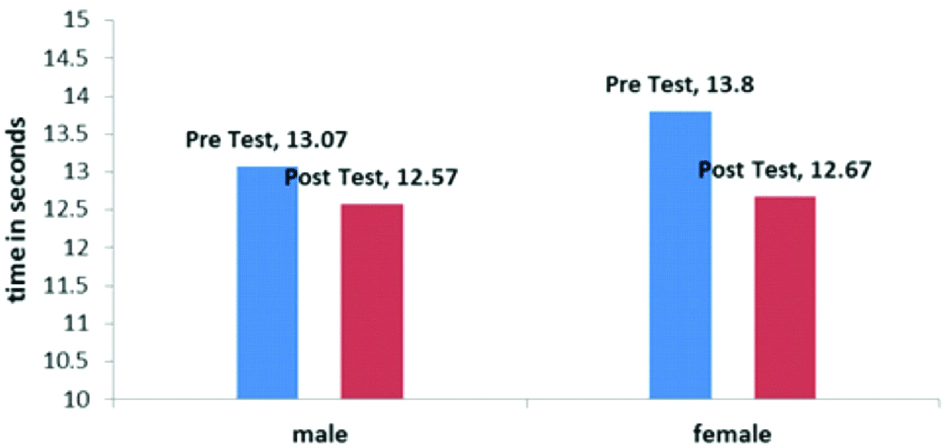As per Donatelli A and Kenji Carp, agility is defined as “a skill-related component of physical fitness that relates to the ability to rapidly change the position of the entire body in space with speed and accuracy” [1].
It is an outcome of a mixture of quick reflexes, coordination, balance, speed, reaction time, strength and neuromuscular control, whereas balance is the ability to maintain the center of gravity within the base of support during stationary as well as dynamic tasks [2].
Agility is an outcome of balance, strength and coordination mainly. Change in any of these key factor components is responsible for agility, cause change in the ‘agility’ of an individual. The trainability of agility skills must depend upon the balance training being one of the components [2].
The balance training program in the study had several reaction-time tasks which were simultaneously performed while challenging the balance by changing the base of support and varying the surface, namely foam and firm surface.
Balance relies upon the integration of afferent impulses, its perception and integration in the central nervous system and an effective motor efferent control generated by the CNS and carried out by the motor system. The afferent system mainly consists of visual, vestibular and the somatosensory system. The somatosensory system comprises of the peripheral receptors that detect any change in posture and position of the body, called as the ‘Proprioceptors’. The efferent system is mainly the musculoskeletal system and requires adequate Range Of Motion (ROM), muscle strength, muscle torque and power production potential as well as endurance [3].
A game of volleyball needs good aerobic strength, anaerobic strength and quick changes of direction in order to chase the ball. Quick and accurate force generation potential is needed for a well-timed and well spotted volley or smash. A player is in constant need of change of direction, speed and change of body posture, all within the confines of the volleyball court and hence needs an effective acceleration and deceleration through space in a very short period of time repetitively for a good performance. According to a study by Gouttebarge V et al., a volleyball player must be able to change direction, sometimes in mid-air in a split second to adjust to the ball. Rapid and sometimes swift movements are required in volleyball as you adjust the body position to the ball [4].
Improving agility can aid in the improvement of the performance of a player by training the ability to accelerate, decelerate, and adjust the body position effectively in the shortest time possible. Agility training can also help in reducing the lower limb injuries as the kinematic chain is trained to face the challenge of sudden changes in direction and force. Balance training included activities like single leg stance, single leg squats, single leg stance with reach outs which could have an effect on lower limb strength, neuromuscular coordination and increased proprioception due to challenge of balancing themselves on foam surface could probably reduce the chances of injury.
This study aims to assess the effect of balance training on agility in volleyball players in the age group of 12-16 years using t-test of agility and to compare the effectiveness of balance training on agility between males and females.
Materials and Methods
This is one group pre-post-test study design. Study was conducted in Asia Pacific World School, Bangalore, Karnataka, India. Duration of the study was 11 months i.e. June 2018 to May 2019. Ethical Committee approval was issued by Krupanidhi College of Physiotherapy, Bangalore. IEC number is EC-FAC/18 /PHY/ 07.
After departmental review and ethical approval, a total of 45 players were screened and 30 of them fulfilled the inclusion and exclusion criteria and were selected for the study by convenient sampling, consisting of 16 females and 14 males.
Inclusion Criteria: Players in age group 12-16 years, players practicing volleyball and sports sessions regularly for at least six months, players willing to participate in the study.
Exclusion Criteria: Players having any recent musculoskeletal injuries in past six months, diagnosed with any other physical or physiological illnesses, players involved in any other form of balance training or agility training in the form of other recreational activities like skating, dancing, swimming, etc. They were excluded from study to rule out the crossover effect of these activities on the balance training protocol by potentially influencing the balance, core strength, lower limb strength, co-ordination, reaction time which will have an effect on the player’s agility.
T-test of Agility
The t-test of agility is used to measure a combination of components that includes agility, leg speed, leg power and it is considered as highly valid and reliable to measure Agility.
In agility t-test, there are four cones A,B,C,D as shown in [Table/Fig-1]. Distance between cone A and cone B is 10 yards and cone B to cone C and cone D on its either side is 5 yards each. The participant stands at the cone A, then sprints forward to touch the base of the cone B with the right hand. From cone B sprints to the cone C on the left side and to touch the base of the cone with the left hand, then sprints back to the cone B in the center. From cone B at the center sprints to the cone D on the right, touches the base of it with the right hand, returns back in the center to touch the base of the cone B and further sprints back to the starting point. The time taken to complete the whole test is noted and fastest of the three trials was considered for the study. Lesser the time taken by the player for completion of the test better is the agility [8].

The demographic data viz., name, gender, age, residential address, parent’s contact and the anthropometric measurements viz., height, weight, BMI were taken by universally accepted standard measures. T-test of agility was carried out twice in the duration of the study at the beginning of the balance training protocol and after the completion of the protocol, at the end of four weeks. The players were thoroughly explained about the procedure of the t-test of agility, and a demonstration of the same was given for their clarity. Each player performed the test three times to yield the best possible performance of the player, making sure that an adequate rest period was provided in between the successive trials. The best of the three trials was considered for the statistical analysis.
After pre-test, four weeks of balance training was given to the players. Players were trained for five days a week for four weeks, once a day. Post training the t-test of agility was repeated in the same manner. The scores of t-test were recorded and were used for data analysis.
Balance Protocol
The balance protocol was designed after taking a baseline measurement of the players. Their performance was correlated with the balance training protocols considered effective in the literature. A final protocol was designed using both the available information.
The protocol was divided into a weekly regime with stepladder progression every week.
[Table/Fig-2] describes the balance protocol given for four weeks to the participants. In 1st and 3rd week, the participants performed the exercises on firm surface. The same exercises were performed in the 2nd and the 4th week as a progression of the challenge by doing them on the foam. The exercises were explained and demonstrated to the participants. The exercise program was closely supervised in order to maintain a good form for all the four weeks.
Balance protocol for 4 weeks.
| Week 1, Firm surface | Week 2, Foam surface | Week 3, Firm surface | Week 4, Foam surface |
|---|
| Tandem standing ball catch and throws20 reps, 2 sets | Tandem standing ball catch and throws20 reps, 2 sets | Single leg stance-ball catch and throws20 reps, 2 sets | Single leg stance- ball catch and throws20 reps, 2 sets |
| One leg cone touch in multiple directions | One leg cone touch in multiple directions | Single leg rowing10 reps, 2 sets | Single leg rowing10 reps, 2 sets |
| Single leg squats and reach outs | Single leg squats and reach outs | Single leg standing with reach outs maintaining knee extension | Single leg standing with reach outs maintaining knee extension |
| Single leg standing and balancing a book on head for 20 seconds | Single leg standing and balancing a book on head for 20 seconds | | |
The t-test of agility was repeated on the players in the similar manner after completion of four weeks of balance training. The readings were recorded and used for data analysis.
Statistical Analysis
Data was then analysed using Microsoft excel and SPSS. The pre and post training scores were compared using paired t-test as the data passed the test of normality.
With the data passing the test of normality and the comparison to be carried out between the pre and post values, paired t-test was used for statistical analysis in both the groups of males and females separately. The mean scores of agility were compared between the groups at the beginning of the study and at the end of balance training to assess the effect of balance training.
Results
Demographic data of the participants is shown in [Table/Fig-3]. The [Table/Fig-4] shows the comparison between the mean scores of agility of the two groups’ pre and post balance training. It shows that there was a significant difference in the means of scores of agility test pre and post balance training (p<0.005) indicating improvement in agility post dynamic balance training.
Demographic data of the participants.
| Groups | n | Mean age | Average weight (kg) | Average height (cm) | Average BMI |
|---|
| Males | 14 | 19.48 | 45.65 | 154.89 | 19.02 |
| Females | 16 | 21.23 | 48.83 | 151.59 | 21.23 |
Comparison of mean time to complete agility T-test-pre and post training.

Comparison of means across genders pre and post training for agility test.

The improvement was seen more in females as compared to males [Table/Fig-5]. The change in the means for pre and post-test performance for males and females is statistically not significant as p>0.05. But the clinical observation of their performances showed greater improvements for females than males. Values indicate that the females showed better response to training than the males.
Discussion
Balance training and agility drills are the essential parts of the professional sports conditioning. It is important in enhancing the performance of the players and reducing the risk of injury. Agility is the crucial component for an athlete for optimal performance. This study mainly considers two important factors of balance and agility: effect of progressive dynamic balance training in improving agility being the first goal and comparing how balance training impacts across the genders in order to change their training needs.
A study by McLeod TC et al., on effects of neuro-muscular training on balance in high school basketball players suggests that neuro muscular training had definite effect in improving balance and agility. Neuromuscular training with tandem standing on firm and foam surface, stability exercises etc improved proprioception and balance [9].
A study published by Saraswat A et al., suggests that four weeks of progressive balance training has an effect in improving agility and dynamic stabilisation. High school basketball players in age 15-20 years showed significant change in performance after four weeks of progressive balance training which included training with key components like hop to reach, single leg standing and activities with single leg standing [10]. Craig BW discussed the neuro physiology of the agility, and suggested that changes in agility are due to the adaptation of neural pathways [11]. Training with progressive dynamic activities lead to improved activation of proprioceptors and overall motor recruitments directing towards improved agility.
According to a systematic review by Zech A et al., on, ‘Balance Training for Neuromuscular Control and Performance Enhancement’ strength training, plyometrics improve strength and speed or sprint performance, whereas balance training improves functional balance. Agility improvement on balance training was found to have conflicting results [12].
The current study was carried out to assess the effect of four weeks of dynamic balance training on agility. The data from the graphs suggests that there was significant improvement in the scores of agility post balance training in both the groups of males and females. Females showed better improvement clinically as compared to males.
Agility is dependent upon different factors such as co-ordination and movement control as well as on the mobility of joints, dynamic balance, power, flexibility, level of energy resources, strength, speed and optimal biomechanical structure of movement [13].
Agility, balance and posture control are interdependent. Effective balance training for various sports has to be tailor-made in order to meet demands of that sport which are variable [14]. Agility is important for good performance in volleyball players for changing their directions in response to the ball, for repetitive jumping and landing and quick changes in direction even in midair. A volleyball player needs a good balance. Balance is important for maintaining equilibrium while suddenly changing the direction of the body in response to the ball in volleyball, either on the ground or in the air while jumping. The neuromuscular training programs that include balance training also reduce sport-related injury risk as well as enhance functional performance after sport injury as it affects proprioception, kinesthetic awareness and muscular strength, core strength [13-15].
The implemented balance training protocol could have probably made an improvement in lower limb strength and core strength as the balance training protocol included single leg standing, single leg squats, single leg standing with reach outs, ball throws which can probably improve isometric, eccentric strength of muscles of lower limb of stance leg as well as core muscles. The changes in stance like tandem standing, single leg stance puts an increased demand on lower limb and core muscles in order to maintain the equilibrium. The agonist-antagonist muscle co-contraction increases by inhibition of muscle stretch reflexes which may lead to increase in joint stiffness and stabilising the joints against any variation which improves balance [10,12].
Dynamic stability training could reinforce the muscles for varying direction in these tests, as well as evolving functional joint motion in field sport athletes. There is reorganisation of the central nervous system, sensorimotor integration and alteration in reaction to movement with upturn in feedback receptor. Further reasons could be accredited to the prompt proprioception sense, preparation of motor neurons in group of muscles and joints to implement the task, increasing coordination and incorporation of motor units, application of synergic muscle, and the process of intensification in inhibiting antagonist muscle [16]. Many studies on balance training have discussed the mechanism as task-specific neural adaptations at the spinal and supraspinal levels. It may suppress spinal reflex excitability such as the muscle stretch reflex during postural tasks, which leads to less destabilising movements and improved balance as required in sports during the activities such as running, jumping changing direction. The improved balance causes reduction in task specific cortical excitability. It is suggested that a shift in movement control from cortical to subcortical and cerebellar structures get encouraged by balance training programmers and becomes an automatic response. Thus, these contribute in improving feed forward mechanism [17-19].
The reaction time can be probably improved due to activities like throwing and catching the ball, single leg cone touch which demands quick reaction to the changes in speed and direction. The probable effect on strength and reaction time can also contribute to the improvement in agility along with the balance training as they are the contributory factors for agility [20].
Limitation
There are few limitations for this study. Sample size was small. Duration for balance training was four weeks and it was the same for all participants. Only single outcome measure, t-test of agility has been used. Carryover effect of the improved agility due to balance training was not considered in this study.
Further studies can be done with larger sample size. In the current study only one parameter was used to assess the efficacy of dynamic balance training in volleyball players, in the further scopes of research multiple outcome measures can be used to confirm the same. Balance improvement post dynamic balance training program was not focused in the current study hence improvement in balance coordination and its cross over with agility was not considered.
Conclusion
Dynamic balance training is effective in improving agility in young volleyball players. Training is equally effective on both the genders. But clinical improvement shows that females have better scope of improvement with dynamic balance training.